Let me put this straight:
Project planning is a challenging and complex activity.
You need to apply knowledge and skills from all aspects of project management. You operate with an enormous amount of information.
And let’s be truthful:
You’ll race against the clock.
Nevertheless, project planning is a structured and logical process.
In this article, I’ll show you a proven workflow. It’s a step-by-step guide to project planning.
For me, planning is one of the most exciting parts of project management. Though, in the beginning, it was the most confusing one.
At each moment of the process, you’re in need of information that you don’t have yet. Most of the processes are interrelated, and you don’t know where to start from.
I tried dozens of different approaches. And I came to a workflow that has a sequential structure.
You use outputs from the previous steps in the next step in the process. And you don’t need to jump from one area to another.
Plan before you act.
How to Create A Simple Project Plan
Some steps might not apply to your environment. You may only need a simple project plan.
Yet, don’t skip steps because they look complicated or you have never done that before.
Every step is important.
You need to evaluate each process. You need to understand it.
Then, you may decide to skip it.
But here’s the trick:
Most likely, you don’t need to skip a step. You need to scale it down or simplify.
It’s Not About Project Management Plan
Here, I focus on the project planning process only.
If you want to learn about a Simple Project Management Plan – I’ve got you covered.
I have put a link to the Project Management Plan article at the end.
Why?
It’s more important that you understand the process.
Project Planning Process Steps
There are many steps in project planning.
Some of them take hours of work. Some of them – days or even weeks.
You may do projects in one company and even for one client.
In such a case, you can reuse the results of the project planning process.
As you gain experience, your project planning steps will become more and more universal.
OK, now let’s dive into the project planning step-by-step guide.
IMPORTANT: Planning is an Iterative Process
Here is a thing:
It is a step-by-step guide to project planning. Right?
But!
Planning is an iterative process.
It means that when you get through each step, you collect more details about the project.
Such details may prompt you to reconsider the results of the previous steps.
Thus, you need to repeat the process several times. For sure, each iteration will take less time. It should not impact the whole project plan.
1. Determine how you will plan the project
How can you do that?
(Especially early in the project when you have little information?)
Yes! But…
You should not start project planning without signed-off Project Charter.
It’s the basis for all your future efforts.
Everything you do on a project should be aligned with one of the other sections of the Project Charter.
“If one does not know to which port one is sailing, no wind is favourable.”
– Lucius Annaeus Seneca
There are two critical points you need to take from the charter:
Firstly, analyze the nature of the project, the main requirements, assumptions, and constraints.
You need to define what project life cycle will work the best. On a high level, it is an adaptive (Scrum, Kanban, RUP) or predictive (waterfall).
You need to align your decision with:
- Company’s culture
- Organizational assets
- Existing policies
- Existing procedures.
For example, your organization works in a waterfall environment. Trying to start a Scrum project will be a bad idea.
So, you need to define the best and the most suitable processes and policies for your environment.
At this step, you do it on a high level.
You might need to create every single process from scratch. It happens when your organization takes a project entirely new in nature.
The second important thing of the Project Charter is the pre-assigned resources.
At this point of project planning, you do not have a team yet. The preassigned personnel will help you define the tasks at hand and required resources.
At this moment, you need to understand how to manage these resources.
2. Determine the required organizational assets, policies, and processes
” You don’t do projects in a vacuum. There is always an environment with policies, processes, and available assets.”
Once again, your project will exist in the environment of your organization.
Really. Keep it in mind all the time.
There’s a preferred project management approach in the organization.
At least there are related mandatory processes and procedures. They’re established to monitor and control critical operations on every project.
There’s also Senior Management of the organization.
They have responsibilities in regards to your project. And you will have to get approvals from them to move your project further.
You need to ensure that you know the requirements and rules of your organization.
So you need to collect templates, tools, and techniques that your organization requires.
Some internal stakeholders might have personal expectations.
You may need to perform Stakeholder Analysis on a high level here as well. You need to take those expectations into account.
(As a side note. You also do Stakeholder Analysis early during project initiation. That’s your second round. You may have some more identification-analysis sessions later during planning)
As for internal stakeholders, you need to collect information about them early on.
The better you understand how your environment works, the smoother your project will pass formalities along the way.
3. Outline the project management plan contents
At the end of project planning, you need to come up with a project management plan.
At this point, you need to draft the key points of each subsidiary plan (e.g., Scope Management Plan, Risk Management Plan, etc.).
Most probably, you can find some templates and instructions in the organizational assets.
For the sake of a simple project plan, you can use Evernote.
Create one notebook for general information. Then, create nested notebooks for subsidiary plans.
Put the notes on the go. You can combine them later.
4. Determine detailed requirements
At this point of the project planning process, you need to define detailed requirements for your project.
(Again, you may need to identify more stakeholders to help you here)
You need to take requirements from the Project Charter. You need to clarify all functional and non-functional aspects what you need to deliver.
It may include sketches, designs, requirements, specifications, performance, safety, or reliability characteristics.
Well, every possible trait and characteristic of the result, service, or product should have.
A good practice is to have a dedicated specialist to collect requirements.
A Business Analytic or a Business System Analytic.
That is a person trained and skilled at systematically defining requirements.
His or her primary responsibility is to build a bridge between a business and a project team.
Yes, they do speak in different languages.
You may not have a business analyst on the team. So, you should ensure that your team understands the business needs of the project.
If you want to learn more about this project planning step, check out this article:
Requirements Gathering Example (Real Software Project)
5. Determine quality standards, processes, and metrics
“Keep in mind that quality standards are unique for the industry and project. No one solution will fit all projects.”
Quality should be an integral part of a project.
Quality has its costs.
It will impact the project schedule, scope, and required resources.
But building quality products is cheaper than dealing with defects and related problems.
So, you need to ensure that compliance with quality standards is the part of your project scope.
More on that is here:
Practical Tips on Quality Assurance From Software Development Projects
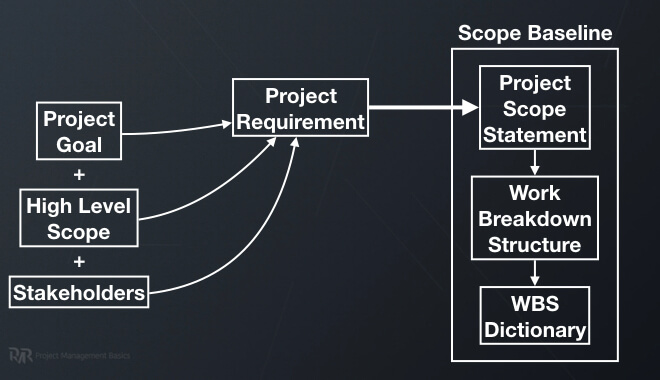
6. Create the Project Scope Statement
You need to make sure that key stakeholders understand and approve the project scope.
Project Scope Statement describes what you will be doing on the project, what you will deliver and how.
Usually, it has a narrative form.
Project Scope Statement includes:
- Project and product scope
- Description of deliverables
- Acceptance criteria
- What is not a part of the project (exclusions)
- Assumptions and constraints.
It is also a good idea to specify places where the scope can be misunderstood and, therefore, may change.
It is best when the Project Scope Statement is formally approved by stakeholders.
Here you can learn more about Project Scope Management:
Project SProject Scope Example: Baseline, Scope Statement, Templates
“Never manage a project alone.”
– Dmytro Nizhebetskyi
7. Determine the Project Management Team
You have an approved project scope statement.
Now you need expert knowledge to proceed.
You can’t and should not try to proceed alone here.
So, it is time to define the resources and expertise you need. You’ll use them to understand the amount of work, complexity, required technologies, etc.
You need to get a senior-level expert from within your company. You can try to secure them for the whole duration of the project.
But sometimes you will help to plan the project with one group of people. Later, you will get your project team.
There is a good starting point:
Talk to your senior and technical management first.
8. Assess what you need to buy or outsource.
Now that you have a clear picture of what you need to deliver. It is a valid time to identify resources and materials that you need to buy.
Parts of the project might be too complicated. You might not have the required expertise in the organization.
Here you can also assess whether outsourcing parts of the project work will have any benefits.
Note that you may get back to these steps several times during project planning.
At some point, you can get more details that have an impact on the project. You need to assess them and make a “create or buy” decisions again.
9. Create a Work Breakdown Structure
WBS is a mandatory artifact on any project.
It is a hierarchical list and/or a diagram that shows 100% of the project scope:
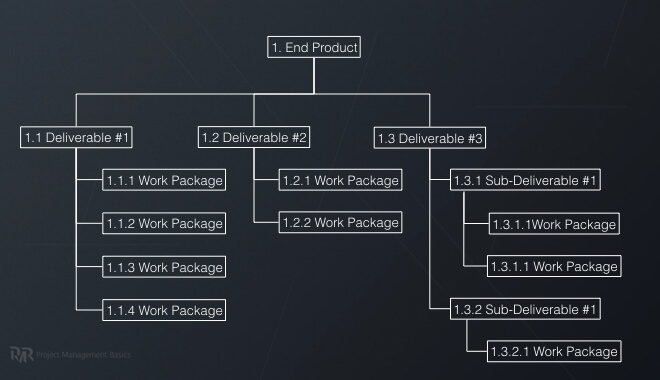
On the highest level, the Work Breakdown Structure has a product or an expected result.
On the second level, there are major deliverables. These deliverables are decomposed into Work Packages.
Work Packages are the pieces of work that are required to deliver a part of the project.
Here is an article on how to create a Work Breakdown Structure:
Work Breakdown Structure Examples (Software, Construction)
10. Create Activities List
Finish creating a WBS.
Then, you need to take each Work Package and define activities (read tasks) that are needed to produce it.
One person should be able to perform an activity from start to finish. It is an outstanding trait each activity should have.
Activities List usually combines a lot of information.
You can put in the activity description, duration and cost estimate, required resources, and materials.
Here is the trick:
Do you have a big project? Then, apply the Rolling Wave Technique.
Rolling Wave Planning is a progressive elaboration technique.
It means you plan for deliverables from the WBS that are closer in the future in more detail.
Elements that are further in the future remain on a high level. But you do plan for them (scope, budget, schedule, risks, etc.).
Later, you elaborate on the details for those WBS elements.
11. Create a Network Diagram
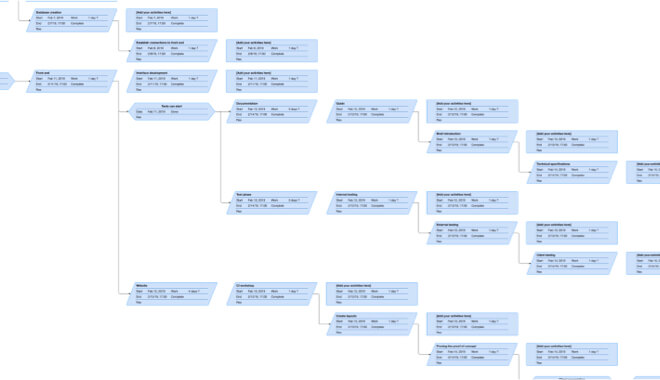
This way or another, all activities are related.
There are many types of dependencies:
External and internal dependencies, hard and soft logic are the main ones.
You may not have any hard technological dependencies. But you do need to sequence all activities out of convenience or efficiency considerations.
Network Diagram shows us the sequence of all activities and their dependencies.
12. Estimate required resources
Once we know what should be done and what should be produced, we can define what resources we need.
It includes experience and a set of skills a person should have. As well as the characteristics of materials and tools that should be used.
It might be confusing when you plan a project for an existing team. In that case, you usually plan for the staff you already have.
13. Estimate duration and costs
Now we know what needs to be done. We know what kind of resources will do it.
We can calculate how much time and money it will take to perform each activity. And how much it will take to get the required materials.
PRO Tips here:
A person that will do the activity should estimate it.
“Be ready to deal with abstract “positions” during project planning. Later you will fill them in with real people. There will be a deviation.”
Find more valuable tips in this article:
But entirely possible you don’t have that person yet.
In this case, you need to estimate the work for a person with an “average performance.”
By the way, don’t forget to include a learning curve for this person in the estimates.
You need to apply appropriate estimation techniques to get the results of the required accuracy.
It is a good practice to log considerations, assumptions, and the basis you used to produce your estimates.
14. Determine the Critical Path
Now you have the Activities ordered in sequences, and you know their duration.
The longest duration path through the network diagram is your Critical Path.
It is the shortest project duration.
Analysis of the critical path can also give you insights into the risky places of your project.
It is always a good idea to determine a near-critical path. It is a path that is close in duration to the critical path. It has a chance of becoming the critical path.
15. Develop a project schedule
At this point of the project planning process, you need to compile the results of the analysis of the network diagram and previous planning efforts.
You may depict your project schedule as a Gantt Chart:
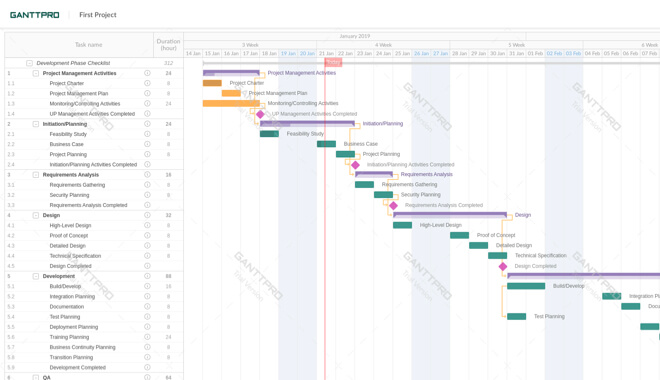
Additionally, you may have a Milestone Chart:
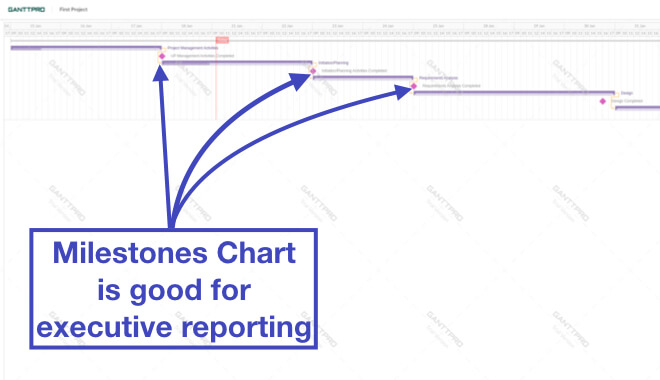
It is an iterative process in itself.
You will update your schedule several times during project planning. At least once you need to incorporate risk response plans.
Once you develop a realistic version of the schedule, it should be approved. But only after risk management activities
After that, it becomes a schedule baseline. You can only change it by formal change requests.
More project management tips on the Schedule here:
How to Create a Project Schedule (step-by-step guide)
16. Develop a budget
Now you should have a clear picture of the work that should be done.
You have estimates of activities, required materials, and resources. You should also understand what work you will outsource.
Jumping ahead, please note that we have not performed risk management yet.
Thus, this is not a cost baseline yet.
You still need to define risk response plans and calculate risk contingency reserves.
17. Create the Process Improvement Plan
A project manager should always try to improve the management and product development processes.
Any improvements should be measurable and must be aligned with some goals.
So, a good practice is to plan such activities.
Otherwise, it will be hard to prove that you achieved some improvement.
Even if you aim for a simple project plan – don’t skip this step.
Continuous improvement is at the heart of Project Management.
18. Determine all roles and responsibilities
Do this later in the project planning process.
Some distinct roles and responsibilities correspond with job descriptions.
But there is always a part of work that lays between the responsibilities of two or more persons.
When you have most of the planning done, you will be able to see more of such problematic zones. So be proactive and clarify such zones.
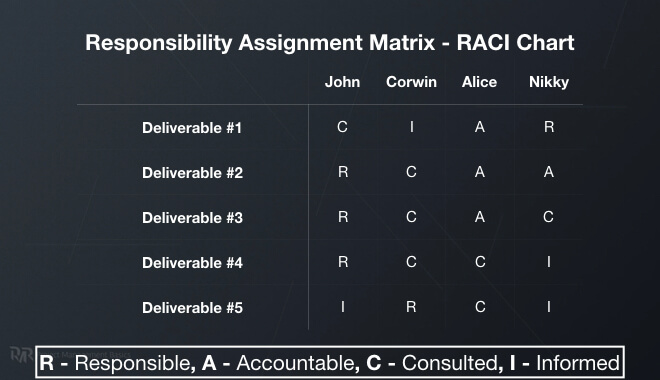
19. Plan project communications
If your team is co-located and you have one point of contact with a customer. It is quite a straightforward plan.
But if you are managing a virtual or a large team.
Or you have lots of important stakeholders.
Then you need to manage and control the informational flow in and out of the team.
At least you need to know the preferred way and time of communication.
Some ground rules for communication are also good practice. You might also want to consider describing the way to escalate problems.
20. Plan stakeholder engagement
During initiation – hopefully – you performed stakeholder analysis.
You may also have a clear understanding of the expectations of key stakeholders.
You should know their attitude towards your project.
Now you need to think about what level of engagement from each stakeholder you want to get.
Then you need an action plan for how you will move their engagement to that point.
It would be really nice to track the progress. So you need some metrics to measure your performance.
21. Perform risk management
It is one of the most critical parts of project planning.
But why do we do it so late?
In fact, an experienced project manager is in a constant mode of identifying risks.
You should look for uncertainties from the project initiation. Usually, you create a draft variant of Risk Register as early as possible.
However, the idea of comprehensive risk management is a bit different:
First, you create a draft plan using the information you have.
You define scope, schedule, budget, and resources. Well, everything that you can identify.
Then, you need to take it all together and make a profound analysis.
You need to identify uncertainties, tight deadlines, short budget, extreme dependencies, external impact, and so on.
“A good plan can help with risk analyses but it will never guarantee the smooth running of the project.”
– Bentley & Borman
Anything that can potentially affect the project should be logged in the Risk Register.
Next, you need to define what can be done to minimize the negative impact or probability of all severe problems.
The actions to be taken should transform into additional activities and reserves of money and time.
They should be added to your plan.
I have it all described in the Project Risk Management section. Check it here:
Risk Management Process Explained (+resources, templates)
22. Validate your plan
After risk management, you will develop risk response plans. They should become a part of your scope, schedule, and budget.
So after you corrected the plan, go back to the beginning and repeat the planning process.
You should walk through the plan and identify residual and new risks.
You should also check that your plan is still realistic and within constraints.
23. Create Baselines
After several iterations of risk management activities, you will come up with a realistic version of the plan.
If it passes validation, you need to create Scope, Schedule, and Cost Baselines.
A baseline is just a final and approved version of your Scope, Budget, or Schedule.
You fix it in stone.
It means they should be formally approved. You use them as a reference point for your project progress.
A baseline is part of the project management plan.
23. Plan ways to measure performance
It is a problem that all novice project managers have.
During project planning, you need to determine ways to measure cost, scope, schedule, risks, and quality performance.
It is also good to know how to measure stakeholder engagement and communications.
If you have integrated project management software, most probably, it will not be a problem for you.
But, if not, tracking efforts and money requires a comprehensive system.
Otherwise, quite soon, your plan will be of no use to you.
Also, keep in mind that you will need to report your progress:
Weekly Project Status Report that Works (+ Template)
24. Create a Change Management Plan
No matter how good your project planning efforts are, changes will happen.
Therefore, you need a process to log, manage, and integrate changes into your project.
You also need a plan on how to prevent changes in the first place.
Read this:
A Simple Guide to Effective Change Management
25. Create a Reward and Recognition system
“Rewards and motivation are an oil change for project engines. Do it regularly and often.”
– Woody Williams
I often see project managers who consider motivation as a casual aspect of management.
So they try to manage it right at the spot.
You need to develop a system beforehand.
There should be clear and transparent rules on how you will reward good work. People need to know how you will recognize their efforts, engagement, and initiative.
But keep in mind that you need to have the ability and budget to provide the benefits.
Learn more about motivation here:
Leadership in Project Management: The Complete Guide
26. Finalize subsidiary plans and create a project plan
Here you need to gather all the components of the project management plan and put it in one piece.
You will need to ensure that all your subsidiary plans are sufficiently detailed.
Add descriptions of processes and charts of a workflow. Finalize all required “How to” aspects of the plan.
As a result, you need to get a realistic plan.
You and your team should be confident with it.
Key stakeholders should believe that you came up with the best possible plan.
Moreover, they should be convinced that you will be able to manage the project according to the plan.
“Getting formal approval is a part of the game.”
– Dmytro Nizhebetskyi
27. Gain formal approval of the plan
Now you need to prove that you and your plan are capable of achieving project goals.
It is a good idea to get approval from all key stakeholders. Sponsor and Customer should give formal approval.
Quite often, this part is not mandatory in organizations.
Project planning is a project manager’s problem. Others are interested in the final result.
However, I strongly encourage you to find a way to present your plan.
It is an essential part of expectations management.
It is like setting rules for the game.
28. Present your plan to the whole team
The last step is to present your plan to the team.
It is vital for them to believe that this plan is feasible. Otherwise, they will not be motivated to follow it. Once you have their buy-in, you are clear to kick off the project.
FAQ on Project Planning Process
How long does it take to plan a project?
For a small project, it may take about one to seven days. For a large project, it may take a month or two. But usually, it includes some initial work during this period.
Who does the planning?
There are different activities in the planning process:
When you collect requirements, there is a lot of work with stakeholders. Plus, you analyze their input with the project team (or assigned temporary resources).
The team should do project scope, estimates of time and costs, and quality assurance. A project manager should facilitate the work.
Risk management is the work for everyone. Include the team, stakeholders, and yourself. There are project management risks.
Project Management Plan, Communication Plan, Procurement Management, and Stakeholder Management are mostly PM’s responsibilities.
How often should you meet with the key stakeholders (customers)?
As often as possible. Ideally, you need a daily meeting for an hour. You may not use the whole 60 minutes, but if there is a need – they should be available.
Take into account your ability to process their input into requirements and specifications. After your meeting, your team needs several days to work on requirements and estimates. In such a case, you can make less frequent meetings
But I prefer daily sessions in any case.
What is the agenda for meetings with customers during project planning?
First, you need to understand the project goal and main constraints. If you didn’t do that earlier – it’s an agenda for the first meeting.
Next, I would keep to the following:
- They provide input on new requirements.
- You ask questions on requirements from previous days.
- You discuss risks and assumptions related to the requirements.
- (later) You discuss estimates for each deliverable.
- (later) You discuss the project schedule.
- (later) You discuss project risks.
- (one-time) You explain the project management approach you will follow.
These are the main points.
Do I need project management software for planning?
Yes, it is proven that project management software increases the chances of project success. Check out some simple tools here:
Project Management Tools, Books, and Resources
If you don’t have one, at least try to keep all project documentation in one place. Google Docs is an OK solution.
What are the key challenges in project planning?
The primary challenge is that you never have enough time — stakeholders want the project team to deliver value from day one.
You are always switching between managing and acquiring a project team, getting new requirements, and updating the project plan all the time.
Where can I get a good project plan template?
You don’t need a template. Create your own.
Follow the process once. You will know what kind of documents you need in the process.
Some of the documents you will create will be of no use later. And that’s OK.
It’s the learning process.
Can I ask more questions about project planning?
Sure! Write me any additional questions in the comments below the article.
I will try to respond as soon as I can.

